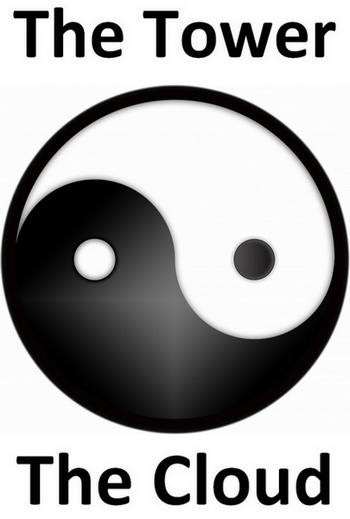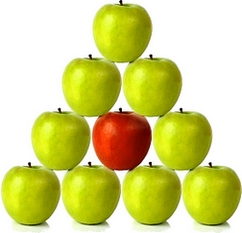 Photo credit: Stelian Ion
New media technologies have ushered us into a new extended environment in which the ability to share, exchange, collaborate and reach out are rewarded spontaneously by the system itself. Inside traditional organizations the forces of hierarchical control and bottom-up spontaneous sharing have finally come to collide on the main deck.
In other words, hierarchical control meets distributed and open self-organizing systems. The tower, meets the cloud. But this needs not be an either / or choice. "It could be a future of and-and-and, where both forms continue to co-exist peacefully."
The "tower" of hierarchy control and the "cloud" of open collaboration are the two extremes of a new continuum in which organizations need yet to learn how to move swiftly.
Today, There are indeed huge opportunities awaiting for those organizations which have not only the courage to acknowledge these deep transformational changes but which have also the will to embrace and integrate these new trends in their own way of working.
Those institutions still resisting these changes are well set on a tragic path of increasing problems, internal tragedies and failures which will become more evident as the two opposing approaches grow further in an open contrast.
On the other hand, our culture, outside large organizations has already converted itself to the new way, embracing in most of its aspects, the distributed power of the "cloud".
Photo credit: Stelian Ion
New media technologies have ushered us into a new extended environment in which the ability to share, exchange, collaborate and reach out are rewarded spontaneously by the system itself. Inside traditional organizations the forces of hierarchical control and bottom-up spontaneous sharing have finally come to collide on the main deck.
In other words, hierarchical control meets distributed and open self-organizing systems. The tower, meets the cloud. But this needs not be an either / or choice. "It could be a future of and-and-and, where both forms continue to co-exist peacefully."
The "tower" of hierarchy control and the "cloud" of open collaboration are the two extremes of a new continuum in which organizations need yet to learn how to move swiftly.
Today, There are indeed huge opportunities awaiting for those organizations which have not only the courage to acknowledge these deep transformational changes but which have also the will to embrace and integrate these new trends in their own way of working.
Those institutions still resisting these changes are well set on a tragic path of increasing problems, internal tragedies and failures which will become more evident as the two opposing approaches grow further in an open contrast.
On the other hand, our culture, outside large organizations has already converted itself to the new way, embracing in most of its aspects, the distributed power of the "cloud".
"All of you have your own hierarchical organizations – because that’s how organizations have always been run. Yet each of you are surrounded by your own clouds: community organizations (both in the real world and online), bulletin boards, blogs, and all of the other Web 2.0 supports for the sharing of connectivity, information, knowledge and power."If your organization is evaluating how to best tackle such strategic issues and approaches to power control, I suggest you reserve a little extra time to immerse yourself in the fantastic journey that Mark Pesce has created in the following essay on Sharing Power inside Organizations. Reading it and having those in power reflect upon it may open some new doors to transforming organizations to leverage the powerful changes already taking place in their internal ranks rather than succumb tragically to painful internal revolutions which only need a little extra time to fully come into full bloom. Is your institution ready to adapt itself and find its way forward into this emerging approach to open sharing power? If not, here's an inspiring tale:
Sharing Power (Aussie Rules)
by Mark PesceFamily Affairs
 In the US state of North Carolina, the New York Times reports, an interesting experiment has been in progress since the first of February.
The "Birds and Bees Text Line" invites teenagers with any questions relating to sex or the mysteries of dating to SMS their question to a phone number.
That number connects these teenagers to an on-duty adult at the Adolescent Pregnancy Prevention Campaign. Within 24 hours, the teenager gets a reply to their text.
The questions range from the run-of-the-mill "When is a person not a virgin anymore?" and the unusual "If you have sex underwater do u need a condom?" to the utterly heart-rending – "Hey, I’m preg and don’t know how 2 tell my parents. Can you help?"
The Birds and Bees Text Line is a response to the slow rise in the number of teenage pregnancies in North Carolina, which reached its lowest ebb in 2003.
Teenagers – who are given state-mandated abstinence-only sex education in school – now have access to another resource, unmediated by teachers or parents, to prevent another generation of teenage pregnancies. Although it’s early days yet, the response to the program has been positive.
Teenagers are using the Birds and Bees Text Line. It is precisely because the Birds and Bees Text Line is unmediated by parental control that it has earned the ire of the more conservative elements in North Carolina.
Bill Brooks, president of the North Carolina Family Policy Council, a conservative group, complained to the Times about the lack of oversight.
In the US state of North Carolina, the New York Times reports, an interesting experiment has been in progress since the first of February.
The "Birds and Bees Text Line" invites teenagers with any questions relating to sex or the mysteries of dating to SMS their question to a phone number.
That number connects these teenagers to an on-duty adult at the Adolescent Pregnancy Prevention Campaign. Within 24 hours, the teenager gets a reply to their text.
The questions range from the run-of-the-mill "When is a person not a virgin anymore?" and the unusual "If you have sex underwater do u need a condom?" to the utterly heart-rending – "Hey, I’m preg and don’t know how 2 tell my parents. Can you help?"
The Birds and Bees Text Line is a response to the slow rise in the number of teenage pregnancies in North Carolina, which reached its lowest ebb in 2003.
Teenagers – who are given state-mandated abstinence-only sex education in school – now have access to another resource, unmediated by teachers or parents, to prevent another generation of teenage pregnancies. Although it’s early days yet, the response to the program has been positive.
Teenagers are using the Birds and Bees Text Line. It is precisely because the Birds and Bees Text Line is unmediated by parental control that it has earned the ire of the more conservative elements in North Carolina.
Bill Brooks, president of the North Carolina Family Policy Council, a conservative group, complained to the Times about the lack of oversight. "If I couldn’t control access to this service, I’d turn off the texting service. When it comes to the Internet, parents are advised to put blockers on their computer and keep it in a central place in the home. But kids can have access to this on their cell phones when they’re away from parental influence – and it can’t be controlled."If I’d stuffed words into a straw man’s mouth, I couldn’t have come up with a better summation of the situation we’re all in right now: young and old, rich and poor, liberal and conservative. There are certain points where it becomes particularly obvious, such as with the Birds and Bees Text Line, but this example simply amplifies our sense of the present as a very strange place, an undiscovered country that we’ve all suddenly been thrust into. Conservatives naturally react conservatively, seeking to preserve what has worked in the past; Bill Brooks speaks for a large cohort of people who feel increasingly lost in this bewildering present.
Replicate The Wikipedia Structure
 Let us assume, for a moment, that conservatism was in the ascendant (though this is clearly not the case in the United States, one could make a good argument that the Rudd Government is, in many ways, more conservative than its predecessor).
Let us presume that Bill Brooks and the people for whom he speaks could have the Birds and Bees Text Line shut down. Would that, then, be the end of it? Would we have stuffed the genie back into the bottle? The answer, unquestionably, is no.
Everyone who has used or even heard of the Birds and Bees Text Line would be familiar with what it does and how it works. Once demonstrated, it becomes much easier to reproduce.
It would be relatively straightforward to take the same functions performed by the Birds and Bees Text Line and "crowdsource" them, sharing the load across any number of dedicated volunteers who might, through some clever software, automate most of the tasks needed to distribute messages throughout the "cloud" of volunteers. Even if it took a small amount of money to setup and get going, that kind of money would be available from donors who feel that teenage sexual education is a worthwhile thing.
In other words, the same sort of engine which powers Wikipedia can be put to work across a number of different "platforms". The power of sharing allows individuals to come together in great "clouds" of activity, and allows them to focus their activity around a single task.
It could be an encyclopedia, or it could be providing reliable and judgment-free information about sexuality to teenagers. The form matters not at all: what matters is that it’s happening, all around us, everywhere throughout the world.
The cloud, this new thing, this is really what has Bill Brooks scared, because it is, quite literally, "out of control". It arises naturally out of the human condition of "hyperconnection". We are so much better connected than we were even a decade ago, and this connectivity breeds new capabilities. The first of these capabilities are the pooling and sharing of knowledge – or "hyperintelligence".
Consider: everyone who reads Wikipedia is potentially as smart as the smartest person who’s written an article in Wikipedia. Wikipedia has effectively banished ignorance born of want of knowledge. The Birds and Bees Text Line is another form of hyperintelligence, connecting adults with knowledge to teenagers in desperate need of that knowledge.
Hyperconnectivity also means that we can carefully watch one another, and learn from one another’s behaviors at the speed of light. This new capability – "hypermimesis" – means that new behaviors, such as the Birds and Bees Text Line, can be seen and copied very quickly. Finally, hypermimesis means that that communities of interest can form around particular behaviors, "clouds" of potential.
These communities range from the mundane to the arcane, and they are everywhere online. But only recently have they discovered that they can translate their community into doing, putting hyperintelligence to work for the benefit of the community.
This is the methodology of the http://www.appcnc.org/Adolescent Pregnancy Prevention Campaign. This is the methodology of Wikipedia. This is the methodology of Wikileaks, which seeks to provide a safe place for whistle-blowers who want to share the goods on those who attempt to defraud or censor or suppress. This is the methodology of ANONYMOUS, which seeks to expose Scientology as a ridiculous cult.
How many more examples need to be listed before we admit that the rules have changed, that the smooth functioning of power has been terrifically interrupted by these other forces, now powers in their own right?
Let us assume, for a moment, that conservatism was in the ascendant (though this is clearly not the case in the United States, one could make a good argument that the Rudd Government is, in many ways, more conservative than its predecessor).
Let us presume that Bill Brooks and the people for whom he speaks could have the Birds and Bees Text Line shut down. Would that, then, be the end of it? Would we have stuffed the genie back into the bottle? The answer, unquestionably, is no.
Everyone who has used or even heard of the Birds and Bees Text Line would be familiar with what it does and how it works. Once demonstrated, it becomes much easier to reproduce.
It would be relatively straightforward to take the same functions performed by the Birds and Bees Text Line and "crowdsource" them, sharing the load across any number of dedicated volunteers who might, through some clever software, automate most of the tasks needed to distribute messages throughout the "cloud" of volunteers. Even if it took a small amount of money to setup and get going, that kind of money would be available from donors who feel that teenage sexual education is a worthwhile thing.
In other words, the same sort of engine which powers Wikipedia can be put to work across a number of different "platforms". The power of sharing allows individuals to come together in great "clouds" of activity, and allows them to focus their activity around a single task.
It could be an encyclopedia, or it could be providing reliable and judgment-free information about sexuality to teenagers. The form matters not at all: what matters is that it’s happening, all around us, everywhere throughout the world.
The cloud, this new thing, this is really what has Bill Brooks scared, because it is, quite literally, "out of control". It arises naturally out of the human condition of "hyperconnection". We are so much better connected than we were even a decade ago, and this connectivity breeds new capabilities. The first of these capabilities are the pooling and sharing of knowledge – or "hyperintelligence".
Consider: everyone who reads Wikipedia is potentially as smart as the smartest person who’s written an article in Wikipedia. Wikipedia has effectively banished ignorance born of want of knowledge. The Birds and Bees Text Line is another form of hyperintelligence, connecting adults with knowledge to teenagers in desperate need of that knowledge.
Hyperconnectivity also means that we can carefully watch one another, and learn from one another’s behaviors at the speed of light. This new capability – "hypermimesis" – means that new behaviors, such as the Birds and Bees Text Line, can be seen and copied very quickly. Finally, hypermimesis means that that communities of interest can form around particular behaviors, "clouds" of potential.
These communities range from the mundane to the arcane, and they are everywhere online. But only recently have they discovered that they can translate their community into doing, putting hyperintelligence to work for the benefit of the community.
This is the methodology of the http://www.appcnc.org/Adolescent Pregnancy Prevention Campaign. This is the methodology of Wikipedia. This is the methodology of Wikileaks, which seeks to provide a safe place for whistle-blowers who want to share the goods on those who attempt to defraud or censor or suppress. This is the methodology of ANONYMOUS, which seeks to expose Scientology as a ridiculous cult.
How many more examples need to be listed before we admit that the rules have changed, that the smooth functioning of power has been terrifically interrupted by these other forces, now powers in their own right?
Affairs of State
 Don’t expect a revolution. We will not see masses of hyperconnected individuals, storming the Winter Palaces of power. This is not a proletarian revolt. It is, instead, rather more subtle and complex.
The entire nature of power has changed, as have the burdens of power. Power has always carried with it the "burden of omniscience" – that is, those at the top of the hierarchy have to possess a complete knowledge of everything of importance happening everywhere under their control. Where they lose grasp of that knowledge, that’s the space where coups, palace revolutions and popular revolts take place.
This new power that flows from the cloud of hyperconnectivity carries a different burden, the "burden of connection". In order to maintain the cloud, and our presence within it, we are beholden to it.
We must maintain each of the social relationships, each of the informational relationships, each of the knowledge relationships and each of the mimetic relationships within the cloud. Without that constant activity, the cloud dissipates, evaporating into nothing at all.
This is not a particularly new phenomenon; Dunbar’s Number demonstrates that we are beholden to the "tribe" of our peers, the roughly 150 individuals who can find a place in our heads. In pre-civilization, the cloud was the tribe.
Should the members of tribe interrupt the constant reinforcement of their social, informational, knowledge-based and mimetic relationships, the tribe would dissolve and disperse – as happens to a tribe when it grows beyond the confines of Dunbar’s Number.
In this hyperconnected era, we can pick and choose which of our human connections deserves reinforcement; the lines of that reinforcement shape the scope of our power.
Studies of Japanese teenagers using mobiles and twenty-somethings on Facebook have shown that, most of the time, activity is directed toward a small circle of peers, perhaps six or seven others. This "co-presence" is probably a modern echo of an ancient behavior, presumably related to the familial unit.
While we might desire to extend our power and capabilities through our networks of hyperconnections, the cost associated with such investments is very high.
Time spent invested in a far-flung cloud is time that lost on networks closer to home. Yet individuals will nonetheless often dedicate themselves to some cause greater than themselves, despite the high price paid, drawn to some higher ideal.
Don’t expect a revolution. We will not see masses of hyperconnected individuals, storming the Winter Palaces of power. This is not a proletarian revolt. It is, instead, rather more subtle and complex.
The entire nature of power has changed, as have the burdens of power. Power has always carried with it the "burden of omniscience" – that is, those at the top of the hierarchy have to possess a complete knowledge of everything of importance happening everywhere under their control. Where they lose grasp of that knowledge, that’s the space where coups, palace revolutions and popular revolts take place.
This new power that flows from the cloud of hyperconnectivity carries a different burden, the "burden of connection". In order to maintain the cloud, and our presence within it, we are beholden to it.
We must maintain each of the social relationships, each of the informational relationships, each of the knowledge relationships and each of the mimetic relationships within the cloud. Without that constant activity, the cloud dissipates, evaporating into nothing at all.
This is not a particularly new phenomenon; Dunbar’s Number demonstrates that we are beholden to the "tribe" of our peers, the roughly 150 individuals who can find a place in our heads. In pre-civilization, the cloud was the tribe.
Should the members of tribe interrupt the constant reinforcement of their social, informational, knowledge-based and mimetic relationships, the tribe would dissolve and disperse – as happens to a tribe when it grows beyond the confines of Dunbar’s Number.
In this hyperconnected era, we can pick and choose which of our human connections deserves reinforcement; the lines of that reinforcement shape the scope of our power.
Studies of Japanese teenagers using mobiles and twenty-somethings on Facebook have shown that, most of the time, activity is directed toward a small circle of peers, perhaps six or seven others. This "co-presence" is probably a modern echo of an ancient behavior, presumably related to the familial unit.
While we might desire to extend our power and capabilities through our networks of hyperconnections, the cost associated with such investments is very high.
Time spent invested in a far-flung cloud is time that lost on networks closer to home. Yet individuals will nonetheless often dedicate themselves to some cause greater than themselves, despite the high price paid, drawn to some higher ideal.
The Example of The Obama Campaign
 The Obama campaign proved an interesting example of the price of connectivity.
During the Democratic primary for the state of New York (which Hilary Clinton was expected to win easily), so many individuals contacted the campaign through its website that the campaign itself quickly became overloaded with the number of connections it was expected to maintain. By election day, the campaign staff in New York had retreated from the web, back to using mobiles.
They had detached from the "cloud" connectivity they used the web to foster, instead focusing their connectivity on the older model of the six or seven individuals in co-present connection. The enormous cloud of power which could have been put to work in New York lay dormant, unorganized, talking to itself through the Obama website, but effectively disconnected from the Obama campaign.
For each of us, connectivity carries a high price. For every organization which attempts to harness hyperconnectivity, the price is even higher.
With very few exceptions, organizations are structured along hierarchical lines. Power flows from bottom to the top. Not only does this create the "burden of omniscience" at the highest levels of the organization, it also fundamentally mismatches the flows of power in the cloud.
When the hierarchy comes into contact with an energized cloud, the "discharge" from the cloud to the hierarchy can completely overload the hierarchy. That’s the power of hyperconnectivity.
Another example from the Obama campaign demonstrates this power. Project Houdini was touted out by the Obama campaign as a system which would get the grassroots of the campaign to funnel their GOTV results into a centralized database, which could then be used to track down individuals who hadn’t voted, in order to offer them assistance in getting to their local polling station.
The campaign grassroots received training in Project Houdini, when through a field test of the software and procedures, then waited for election day.
On election day, Project Houdini lasted no more than 15 minutes before it crashed under the incredible number of empowered individuals who attempted to plug data into Project Houdini. Although months in the making, Project Houdini proved that a centralized and hierarchical system for campaign management couldn’t actually cope with the "cloud" of grassroots organizers.
In the 21st century we now have two oppositional methods of organization: the hierarchy and the cloud. Each of them carry with them their own costs and their own strengths. Neither has yet proven to be wholly better than the other.
One could make an argument that both have their own roles into the future, and that we’ll be spending a lot of time learning which works best in a given situation. What we have already learned is that these organizational types are mostly incompatible: unless very specific steps are taken, the cloud overpowers the hierarchy, or the hierarchy dissipates the cloud. We need to think about the interfaces that can connect one to the other.
That’s the area that all organizations – and very specifically, non-profit organizations – will be working through in the coming years. Learning how to harness the power of the cloud will mark the difference between a modest success and overwhelming one. Yet working with the cloud will present organizational challenges of an unprecedented order. There is no way that any hierarchy can work with a cloud without becoming fundamentally changed by the experience.
The Obama campaign proved an interesting example of the price of connectivity.
During the Democratic primary for the state of New York (which Hilary Clinton was expected to win easily), so many individuals contacted the campaign through its website that the campaign itself quickly became overloaded with the number of connections it was expected to maintain. By election day, the campaign staff in New York had retreated from the web, back to using mobiles.
They had detached from the "cloud" connectivity they used the web to foster, instead focusing their connectivity on the older model of the six or seven individuals in co-present connection. The enormous cloud of power which could have been put to work in New York lay dormant, unorganized, talking to itself through the Obama website, but effectively disconnected from the Obama campaign.
For each of us, connectivity carries a high price. For every organization which attempts to harness hyperconnectivity, the price is even higher.
With very few exceptions, organizations are structured along hierarchical lines. Power flows from bottom to the top. Not only does this create the "burden of omniscience" at the highest levels of the organization, it also fundamentally mismatches the flows of power in the cloud.
When the hierarchy comes into contact with an energized cloud, the "discharge" from the cloud to the hierarchy can completely overload the hierarchy. That’s the power of hyperconnectivity.
Another example from the Obama campaign demonstrates this power. Project Houdini was touted out by the Obama campaign as a system which would get the grassroots of the campaign to funnel their GOTV results into a centralized database, which could then be used to track down individuals who hadn’t voted, in order to offer them assistance in getting to their local polling station.
The campaign grassroots received training in Project Houdini, when through a field test of the software and procedures, then waited for election day.
On election day, Project Houdini lasted no more than 15 minutes before it crashed under the incredible number of empowered individuals who attempted to plug data into Project Houdini. Although months in the making, Project Houdini proved that a centralized and hierarchical system for campaign management couldn’t actually cope with the "cloud" of grassroots organizers.
In the 21st century we now have two oppositional methods of organization: the hierarchy and the cloud. Each of them carry with them their own costs and their own strengths. Neither has yet proven to be wholly better than the other.
One could make an argument that both have their own roles into the future, and that we’ll be spending a lot of time learning which works best in a given situation. What we have already learned is that these organizational types are mostly incompatible: unless very specific steps are taken, the cloud overpowers the hierarchy, or the hierarchy dissipates the cloud. We need to think about the interfaces that can connect one to the other.
That’s the area that all organizations – and very specifically, non-profit organizations – will be working through in the coming years. Learning how to harness the power of the cloud will mark the difference between a modest success and overwhelming one. Yet working with the cloud will present organizational challenges of an unprecedented order. There is no way that any hierarchy can work with a cloud without becoming fundamentally changed by the experience.
Affair De Coeur
 All organizations are now confronted with two utterly divergent methodologies for organizing their activities: the tower and the cloud.
All organizations are now confronted with two utterly divergent methodologies for organizing their activities: the tower and the cloud.
- The tower seeks to organize everything in hierarchies, control information flows, and keep the power heading from bottom to top.
- The cloud isn’t formally organized, pools its information resources, and has no center of power. Despite all of its obvious weaknesses, the cloud can still transform itself into a formidable power, capable of overwhelming the tower. To push the metaphor a little further, the cloud can become a storm.
The Cloud Model
 This is the model for Wikipedia, for Wikileaks, and for ANONYMOUS. This is the cloud model, fully actualized as a storm. At this point the storm can challenge any tower.
But the storm doesn’t have things all its own way; to present a challenge to a tower is to invite the full presentation of its own power, which is very rude, very physical, and potentially very deadly. Wikipedians at work on the Farsi version of the encyclopedia face arrest and persecution by Iran’s Revolutionary Guards and religious police.
Just a few weeks ago, after the contents of the Australian government’s internet blacklist was posted to Wikileaks, the German government invaded the home of the man who owns the domain name for Wikileaks in Germany. The tower still controls most of the power apparatus in the world, and that power can be used to squeeze any potential competitors.
But what happens when you try to squeeze a cloud? Effectively, nothing at all. Wikipedia has no head to decapitate. Jimmy Wales is an effective cheerleader and face for the press, but his presence isn’t strictly necessary.
There are over 2000 Wikipedians who handle the day-to-day work. Locking all of them away, while possible, would only encourage further development in the cloud, as other individuals moved to fill their places.
Moreover, any attempt to disrupt the cloud only makes the cloud more resilient. This has been demonstrated conclusively from the evolution of "darknets", private file-sharing networks, which grew up as the legal and widely available file-sharing networks, such as Napster, were shut down by the copyright owners.
Attacks on the cloud only improve the networks within the cloud, only make the leaders more dedicated, only increase the information and knowledge sharing within the cloud. Trying to disperse a storm only intensifies it.
These are not idle speculations; the tower will seek to contain the storm by any means necessary. The 21st century will increasingly look like a series of collisions between towers and storms. Each time the storm emerges triumphant, the tower will become more radical and determined in its efforts to disperse the storm, which will only result in a more energized and intensified storm. This is not a game that the tower can win by fighting. Only by opening up and adjusting itself to the structure of the cloud can the tower find any way forward.
What, then, is leadership in the cloud? It is not like leadership in the tower. It is not a position wrought from power, but authority in its other, and more primary meaning, "to be the master of". Authority in the cloud is drawn from dedication, or, to use rather more precise language, love. Love is what holds the cloud together.
People are attracted to the cloud because they are in love with the aim of the cloud. The cloud truly is an affair of the heart, and these affairs of the heart will be the engines that drive 21st century business, politics and community.
Author and pundit Clay Shirky has stated, "The internet is better at stopping things than starting them". I reckon he’s wrong there: the internet is very good at starting things that stop things. But it is very good at starting things.
Making the jump from an amorphous cloud of potentiality to a forceful storm requires the love of just five people. That’s not much to ask. If you can’t get that many people in love with your cause, it may not be worth pursing.
This is the model for Wikipedia, for Wikileaks, and for ANONYMOUS. This is the cloud model, fully actualized as a storm. At this point the storm can challenge any tower.
But the storm doesn’t have things all its own way; to present a challenge to a tower is to invite the full presentation of its own power, which is very rude, very physical, and potentially very deadly. Wikipedians at work on the Farsi version of the encyclopedia face arrest and persecution by Iran’s Revolutionary Guards and religious police.
Just a few weeks ago, after the contents of the Australian government’s internet blacklist was posted to Wikileaks, the German government invaded the home of the man who owns the domain name for Wikileaks in Germany. The tower still controls most of the power apparatus in the world, and that power can be used to squeeze any potential competitors.
But what happens when you try to squeeze a cloud? Effectively, nothing at all. Wikipedia has no head to decapitate. Jimmy Wales is an effective cheerleader and face for the press, but his presence isn’t strictly necessary.
There are over 2000 Wikipedians who handle the day-to-day work. Locking all of them away, while possible, would only encourage further development in the cloud, as other individuals moved to fill their places.
Moreover, any attempt to disrupt the cloud only makes the cloud more resilient. This has been demonstrated conclusively from the evolution of "darknets", private file-sharing networks, which grew up as the legal and widely available file-sharing networks, such as Napster, were shut down by the copyright owners.
Attacks on the cloud only improve the networks within the cloud, only make the leaders more dedicated, only increase the information and knowledge sharing within the cloud. Trying to disperse a storm only intensifies it.
These are not idle speculations; the tower will seek to contain the storm by any means necessary. The 21st century will increasingly look like a series of collisions between towers and storms. Each time the storm emerges triumphant, the tower will become more radical and determined in its efforts to disperse the storm, which will only result in a more energized and intensified storm. This is not a game that the tower can win by fighting. Only by opening up and adjusting itself to the structure of the cloud can the tower find any way forward.
What, then, is leadership in the cloud? It is not like leadership in the tower. It is not a position wrought from power, but authority in its other, and more primary meaning, "to be the master of". Authority in the cloud is drawn from dedication, or, to use rather more precise language, love. Love is what holds the cloud together.
People are attracted to the cloud because they are in love with the aim of the cloud. The cloud truly is an affair of the heart, and these affairs of the heart will be the engines that drive 21st century business, politics and community.
Author and pundit Clay Shirky has stated, "The internet is better at stopping things than starting them". I reckon he’s wrong there: the internet is very good at starting things that stop things. But it is very good at starting things.
Making the jump from an amorphous cloud of potentiality to a forceful storm requires the love of just five people. That’s not much to ask. If you can’t get that many people in love with your cause, it may not be worth pursing.
How Organization Can Embrace The Cloud
 All 21st century organizations need to recognize and adapt to the power of the cloud.
It’s either that or face a death of a thousand cuts, the slow ebbing of power away from hierarchically-structured organizations as newer forms of organization supplant them. But it need not be this way. It need not be an either / or choice. It could be a future of and-and-and, where both forms continue to co-exist peacefully. But that will only come to pass if hierarchies recognize the power of the cloud.
This means you. All of you have your own hierarchical organizations – because that’s how organizations have always been run. Yet each of you are surrounded by your own clouds: community organizations (both in the real world and online), bulletin boards, blogs, and all of the other Web 2.0 supports for the sharing of connectivity, information, knowledge and power.
You are already halfway invested in the cloud, whether or not you realize it. And that’s also true for people you serve, your customers and clients and interest groups. You can’t simply ignore the cloud.
All 21st century organizations need to recognize and adapt to the power of the cloud.
It’s either that or face a death of a thousand cuts, the slow ebbing of power away from hierarchically-structured organizations as newer forms of organization supplant them. But it need not be this way. It need not be an either / or choice. It could be a future of and-and-and, where both forms continue to co-exist peacefully. But that will only come to pass if hierarchies recognize the power of the cloud.
This means you. All of you have your own hierarchical organizations – because that’s how organizations have always been run. Yet each of you are surrounded by your own clouds: community organizations (both in the real world and online), bulletin boards, blogs, and all of the other Web 2.0 supports for the sharing of connectivity, information, knowledge and power.
You are already halfway invested in the cloud, whether or not you realize it. And that’s also true for people you serve, your customers and clients and interest groups. You can’t simply ignore the cloud.
How then should organizations proceed?
1) Do Not Be Scared of The Cloud
It might be some time before you can come to love the cloud, or even trust it, but you must at least move to a place where you are not frightened by a constituency which uses the cloud to assert its own empowerment. Reacting out of fright will only lead to an arms race, a series of escalations where the your hierarchy attempts to contain the cloud, and the cloud – which is faster, smarter and more agile than you can ever hope to be – outwits you, again and again.
2) Like Likes Like
If you can permute your organization so that it looks more like the cloud, you’ll have an easier time working with the cloud. Case in point: because of "message discipline", only a very few people are allowed to speak for an organization. Yet, because of the exponential growth in connectivity and Web 2.0 technologies, everyone in your organization has more opportunities to speak for your organization than ever before. Can you release control over message discipline, and empower your organization to speak for itself, from any point of contact? Yes, this sounds dangerous, and yes, there are some dangers involved, but the cloud wants to be spoken to authentically, and authenticity has many competing voices, not a single monolithic tone.
3) We Are All Involved In a Growth Process
The cloud of last year is not the cloud of next year. The answers that satisfied a year ago are not the same answers that will satisfy a year from now. We are all booting up very quickly into an alternative form of social organization which is only just now spreading its wings and testing its worth. Beginnings are delicate times. The future will be shaped by actions in the present. This means there are enormous opportunities to extend the capabilities of existing organizations, simply by harnessing them to the changes underway. It also means that tragedies await those who fight the tide of times too single-mindedly. Our culture has already rounded the corner, and made the transition to the cloud. It remains to be seen which of our institutions and organizations can adapt themselves, and find their way forward into sharing power.
Originally written by Mark Pesce for The Human Network, and first published on May 10th 2009 as "Sharing Power (Aussie Rules)".
About the author
 Mark Pesce is a Sydney based consultant, writer and lecturer. His consultancy, FutureSt, advises media companies in publishing and broadcasting on strategies for forward movement in an ever more fragmented and converged media marketplace.
Mark Pesce is a Sydney based consultant, writer and lecturer. His consultancy, FutureSt, advises media companies in publishing and broadcasting on strategies for forward movement in an ever more fragmented and converged media marketplace.
Photo credits: Family Affairs - TatyanaGI Replicate The Wikipedia Structure - Andres Rodriguez Affairs of State - Irina Tischenko The Example of The Obama Campaign - Peter Howe Affair De Coeur - Lars Christensen The Cloud Model - Nikolai Sorokin How Organization Can Embrace The Cloud - Kyle Smith

